



Update: LEDs for Broiler House Lighting
The National Poultry Technology Center (NPTC) at Auburn University has been closely monitoring broiler house lighting developments over the past several years. Gene Simpson, Dennis Brothers, Jess Campbell and Jim Donald share their experiences and offer advice over the best choices for broiler growers.The broiler industry relied almost totally on incandescent lights for both grow-out and brooding until around 2006-2007, when considerably more energy efficient cold cathode (CCFL) and compact fluorescent (CFL) lights began appearing. Many growers began replacing brood lights with non-dimmable spiral CFLs and grow-out lights with either CCFL or dimmable CFL. The typical end result was an annual power bill reduction of $1,000 or more for a typical 40-foot × 500-foot broiler house with 50 to 54 feed line grow-out lights and 12 to 14 centre-line brood lights. However, both the CCFL and dimmable CFL grow-out lights began showing a number of problems, such as light level reductions and, in some cases, caused slight performance reductions over time.
In 2008-2011, several new light emitting diode (LED) lights became available. Unfortunately, most of these LEDs were very expensive, and in some cases, they did not hold up or perform well in the harsh environment of a poultry house. As a result, and in the absence of rebate or cost-share programs, most growers made a business decision not to install LEDs until their quality, longevity, cost and warranty improved.
Those improvements, for the most part, began occurring in 2010-2011 and have continued at a rapid rate. We now have very reliable, fairly inexpensive LEDs available with longer warranties.
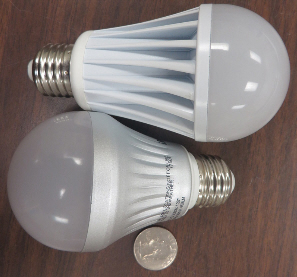
in dropped-ceiling houses. Fins dissipate heat, helping extend bulb life and maintain light intensity;
however, cleaning between flocks is especially important for finned types.
More than two years ago, the NPTC began installing and closely monitoring several brands and models of LEDs in multiple houses on a large number of farms across the 'Broiler Belt'.
Based on the data collected, the authors report that most of the LEDs currently available do a great job of helping to raise the best broiler possible, and do that at the lowest possible cost. They offer a caution, however; commercial-grade LEDs, available from most poultry supply firms, should be used rather than residential-grade LEDs from building and home supply outlets.
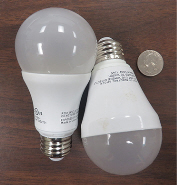
light output. A19s work well as grow lights in dropped-ceiling broiler houses.
Factors to Consider Before a House Lighting Upgrade
1. Be realistic in calculating costs/savings
A watt is a watt is a watt. Significant power bill savings occur when incandescent bulbs are replaced with LEDs, not in replacing one low wattage bulb with a different bulb of close to the same wattage. For example, replacing 52 10-watt bulbs with 52 nine-watt bulbs will reduce a grower’s annual power bill by only about $20. However, replacing 52 75-watt incandescent bulbs with 52 10-watt LEDs will yield a saving of about $1,200 to $1,400. The LED purchase cost could range from less than $800 to more than $2,000, with basically the same lighting level and performance results.
In comparing costs of usage for different models or brands, advertised 'power factor', a measure of electrical efficiency, can usually be disregarded. All LEDs have similarly high power factor ratings, and Alabama Power Company engineers have estimated that the annual value of even a 10 per cent LED power factor improvement for a poultry house with 52 LED bulbs is no more than about $20 to $25.
Remember, a smart business decision will also include comparing warranties – which range from three to five years – and possible rebate and incentive programme savings, which might save as much as 70 per cent.
2. Get the light intensity you need
All light intensity (brightness) is measured in lumens of output. In measuring light intensity, we are interested in lumen levels achieved at bird level. In the US, this is measured in foot-candles (fc) which is lumens per square foot and in metric countries, it is measured in lux (lumens per square metre). 1 fc = 10.76 lux (approximately 10 lux per fc).
With the directional output of LEDs, a bulb producing 500 lumens will typically provide comparable fc/lux readings to a non-directional bulb with 1,500 or more lumens. Footcandles and lux are standard units of measurements, and the fc/lux measurement at bird level is the appropriate comparison to make when evaluating different LED brands and styles.
Overall lamp efficiency is measured in lumens per watt (lm/w). Most LEDs are in the range of 55 to 65 lumens per watt; however several recently introduced models are 80-85 or more lumens per watt.
Most of these new higher output, higher efficiency LEDs have been designed to better dissipate the added heat they generate. All lights lose light intensity over time. However, lumen depreciation for LEDs is usually less than 10 per cent per year but typically 15 to 25 per cent per year for CCFLs and CFLs.
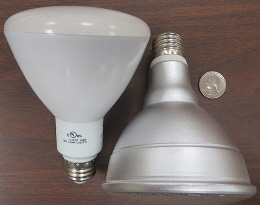
3. Look for certification
All LEDs purchased should be UL-certified, at a minimum. Other important certifications which are typically seen are Energy Star and Lighting Design Labs-LM79. Energy Star is unable to certify any LED with a colour over 4000°K; Lighting Design Labs will certify LEDs over 4000°K.
Depending on LED colour, either certification is acceptable, and ensures that the LED has been independently tested and has passed all certification requirements. Avoid any LEDs that do not have either of these two certifications.
4. Consider dimmability
Most LEDs dim very smoothly to extremely low light output levels with the most common commercial poultry house dimmers. However, some LED brands exhibit dimming problems at very low dimmer settings, and may actually require the use of one or more incandescent bulbs to achieve acceptable, consistent, and smooth low-end dimming.
Several new LED-specific dimmers are now available which can be optimised for most any LED brand.
*
"All LEDs have directional light output, so they are capable of providing higher bird level light with far less power consumption, since all emitted light is directed towards the floor. The greater the beam angle of the bulb, the broader the light spread."
5. Get uniform light spread
Some brands and shapes of LEDs produce very uniform side-to-side, end-to-end lighting and some simply do not. Some LED models concentrate their light output in a small area while others spread the light more evenly over a larger area.
In general, the authors report, they have observed most brands of A19 shaped LEDs to have better uniformity than PAR and hybrid shaped LEDs in dropped ceiling houses where mounting heights are relatively low (9 to 10 feet), while PAR and hybrid shaped LEDs tend to provide better uniformity in open truss houses where mounting height is higher (more than 10 feet).
Open truss houses also need higher lumen output LEDs to allow for the higher mounting height, and may benefit from the use of reflectors.
6. Beat the heat
Excessive heat will shorten bulb life and reduce its light output over time.
Some LED models have external metal or plastic heat sinks to promote cooling, and some of these fins are quite large. Unfortunately, in poultry houses, these fins can quickly become clogged with dirt and debris leading to increased heat build-up, decreased light output over time and shorter bulb life.
Some LED manufacturers have succeeded in developing bulbs with no external fins, yet do not overheat.
It is a good idea to clean all lights, LED or CFL, between every flock. You can use a hand-held pressure sprayer with the nozzle turned to jet stream and spray off each bulb for a few seconds.
NPTC has found that a 10 per cent solution of household ammonia or window cleaner works well. Simply power off the lights, spray them, and allow them to drip dry.
7. Aim to match brood light and grow light colours
Light colour is the visible spectrum wavelength expressed in degrees Kelvin (°K). Most LEDs range from 3000 to 5000°K. 3000°K lights (warm white) have a yellow-white appearance; 5000°K lights (cool white or daylight) have a blue-white appearance.
For comparison, most incandescent lights are 2800°K and most non-dim CFLs and CCFLs are 2700-2850°K, although cooler white incandescent bulbs, CFLs and CCFLs are readily available.
Light colour selection should be based on the integrator’s preference. In choosing LEDs, be wary of claims of better bird performance strictly due to light colour. Within the 3000 to 5000°K range, such claims have been shown to be highly questionable.
Protect your investment: use nickel-plated, not aluminium lighting sockets. Aluminium screw-sockets are cheaper but subject to rapid corrosion, early failure and possible dimmer interference.
8. Don’t count on performance gains
Improvements in mortality, feed conversion, weight, average daily gain etc. with LEDs have not been consistently demonstrated or replicated in unbiased comparison tests, as long as the lighting levels being compared were the same.
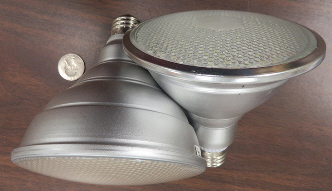
eighths of an inch the lens is wide. PAR bulbs are most useful in higher wattages as grow lights in open truss ceiling broiler houses. Bulbs pictured above are PAR 38.
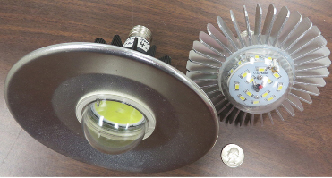
and heat-shedding capability. Like PAR bulbs, they are often used in open truss ceiling houses.
The Bottom Line
The NPTC suggests you shop for LEDs wisely. Before you commit to one brand of LED, think about what you are trying to accomplish, namely raising the best broiler possible while at the same time minimizing your ownership cost and utility bills.
Do not be swayed by various marketing and sales claims. Consider what you are trying to accomplish, what you need and then spend time looking. Ask questions and compare as much as possible. Talk to other growers and live production people who have experience with multiple LED brands. Require honesty and if you do not sense that you get it, walk away and keep looking.
Carefully consider the purchase or ownership cost, operational cost and warranty, and explore rebate and incentive programmes that might be available in your area.
Look for cost savings but do not expect performance improvements – they are, of course, tied to many more factors than just lighting. Explore and weigh all your options and then make a smart business decision.
|
In general, the NPTC has found that using LED dimmable grow lights (around 500 lumens) with spiral CFL brood lights of sufficient lumen output needed to achieve the company’s specific minimum footcandle (fc) requirement, typically as measured along feeder lines, is the most cost-effective approach for broiler lighting in dropped ceiling houses. Most companies recommend or require a minimum average 3-5 fc along the feeders during brood, with progressive dimming to 0.25 fc or lower at the end of flock, depending on the flock’s target weight. (Bigger birds typically finish at very dim levels (<0.05 fc). Here are a few example lighting lay-outs that have been successful for growers: A) 40 feet wide, dropped ceiling, two grow lines 20-foot OC over feeders with centre brood line in brood chamber These houses typically will use 6-8 watt dimmable A19 shaped LED grow lights and 55 watt spiral CFL brood lights. This layout will provide 3+ fc along feeders; however, much higher fc readings will be found in the middle of the house. B) 40 feet wide, dropped ceiling, two grow lines 20-foot OC with alternating brood lines over feeders in brood chamber, also 20-foot OC These houses typically will use 6-8 watt dimmable A19 shaped LED grow lights and 23-26 watt or 40-42 watt spiral CFL brood lights. This layout concentrates lighting over the feeders in brood better than B. above. C. 40 feet wide, dropped ceiling, two brood line in brood chamber These houses typically will use 6-8 watt dimmable A19 shaped LED grow lights and 23-26 watt or 40-42 watt spiral CFL brood lights per splitter in the brood area, and 6-8 watt LED only in the off-brood area. This layout concentrates lighting over the feeders in brood nearly as well as (B) above. D) 50-54 feet wide, dropped ceiling, three or four grow lines, 16-20 feet OC with alternating brood lines over feeders in brood chamber These houses typically will use 6-8 watt A19 shaped dimmable LED grow lights and 23-26 watt or 40-42 watt spiral CFL brood lights. E. 60-66 feet wide, dropped ceiling, three or four grow lines, 16 feet OC with alternating brood lines over feeders in brood chamber These houses typically will use 6-8 watt A19 shaped dimmable LED grow lights and 23-26 watt or 40-42 watt spiral CFL brood lights. Open Truss Houses Similar to dropped ceiling houses but with higher output LED grow lights (700-900 lumen; either A19, PAR or hybrid shape) and spiral CFL brood bulbs to account for decreased floor fc levels due to increased mounting heights of several feet. A reflector device on spiral CFL brood bulbs helps direct all brood light toward the floor. |
July 2014








